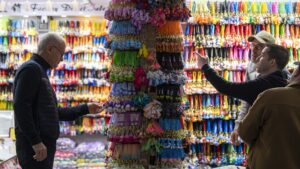The Christmas Creep: Navigating Tariffs and Supply Chain Challenges
As the festive season approaches, the retail landscape is buzzing with activity. For years, retailers have embraced the phenomenon known as "Christmas creep," where holiday merchandise starts appearing on shelves earlier than ever. It’s a strategic move to tap into the lucrative holiday economy. However, 2024 poses a unique challenge for these businesses, thanks in large part to tariff uncertainties impacting supply chains, particularly those dependent on imports from China.
The Tariff Dilemma
Following the introduction of significant tariffs by the U.S. government, many retailers found themselves in uncharted waters. Initially rolled out under the Trump administration, these tariffs included a whopping 34% on imports from China, later escalating to 145%. Such steep increases prompted many U.S. retailers to pause orders from Chinese suppliers, resulting in factories halting production. This chain reaction has raised concerns about the availability of products just when they’re most needed.
Cameron Johnson, a senior partner at Tidalwave Solutions in Shanghai, articulated the urgency: “If you don’t start producing in the next couple of weeks, you’re going to start missing Black Friday and Christmas.” This sentiment underscores the precarious balance retailers must maintain between managing costs and meeting consumer demand.
Supply Chains and Production Timelines
The intricacies of supply chains cannot be overstated. Johnson illustrated the interdependencies in manufacturing—pausing orders for seemingly simple items, like spoons, impacts upstream suppliers like steel manufacturers and iron ore smelters. This ripple effect means that a halt in orders could potentially paralyze entire supply chains, making recovery slow and fraught with complications.
A Goldman Sachs report revealed that a staggering 36% of U.S. imports from China rely on goods that can only be sourced from mainland suppliers. Consequently, logistical challenges arise when trying to reroute production or find alternative suppliers, particularly for specialized products like electronics, which require rigorous testing and assembly. Renaud Anjoran, CEO of Agilian Technology, pointed out that products destined for U.S. shelves need to be shipped out of China by early September, demanding preparations to begin as early as March.
Shipping Trends and Inventory Strategies
Faced with tariff uncertainties, many retailers began stockpiling inventories to mitigate future costs. This preemptive strategy led to a 9.1% uptick in China’s exports to the U.S. in March, while imports experienced a 9.5% decline. However, recent reports indicate that these front-loading efforts are starting to falter; the number of cargo-carrying container ships departing China has significantly dropped, along with a remarkable 14-fold increase in canceled shipments.
Anjoran noted that the volume of purchase orders from U.S. customers is currently lower than expected. Many companies have sufficient stock on hand, leading to a lukewarm demand for new inventory. For retailers, this standoff presents a dual challenge: maintaining shelves and managing costs effectively.
Strategic Adjustments and Future Outlook
Despite potential tariff relief, the path forward remains uncertain. Some U.S. businesses, particularly in textiles, are opting to hold off on production until a clearer picture emerges regarding tariffs. Fortunately, recent negotiations have yielded some tariff exemptions for select goods, including pharmaceuticals and electronics, providing a glimmer of hope.
In the face of increasing costs and economic pressures, companies are adopting an agile approach. By partially refilling past orders rather than placing bulk orders, retailers aim to balance inventory needs without incurring steep costs. Johnson relayed that some factories have received green lights from major retailers like Walmart and Target to restart production, showing a willingness from both sides to adapt.
However, a rush to backfill these orders could spike production costs, as overwhelmed factories might struggle to meet increased demand. As Anjoran cautioned, “If all American customers rush at the same time, the factories are going to be overwhelmed, and air shipments will be quite expensive.”
Conclusion: Staying Ahead in a Dynamic Environment
For retailers and investors alike, the holiday season of 2024 presents unique opportunities and challenges. As we approach this critical time, understanding the intricate dynamics of tariffs and supply chains can help businesses make informed decisions. At Extreme Investor Network, we encourage our readers to stay vigilant, strategize wisely, and navigate these turbulent waters with foresight and flexibility.
With thoughtful planning and awareness of market trends, you can emerge resilient and ready to meet consumer demands—ensuring that your shelves are stocked and your business thrives, even amidst uncertainty.
Stay connected for more insights and expert analysis to keep you ahead in the ever-evolving landscape of finance and retail!

